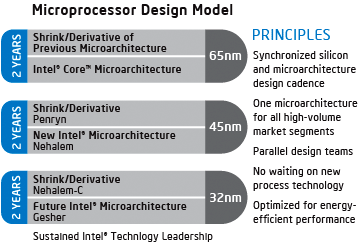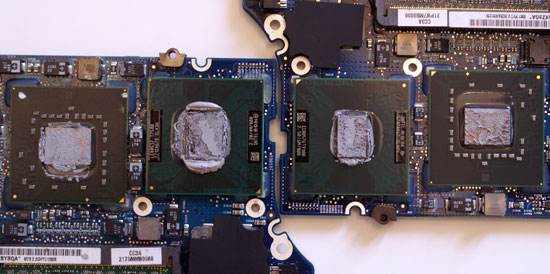Apple’s 45nm Refresh: New MacBook & MacBook Pro
by Anand Lal Shimpi on February 29, 2008 12:00 AM EST- Posted in
- Mac
Setting Expectations
An old middle school friend of mine is obsessed with Apple these days. She’s always asking me Mac questions or trying to get an idea of what’s coming down the pipe (Steve: if you’re listening, she’d drop her Palm in a heartbeat if she could edit Word/Excel docs on the iPhone).
Lately she’s been asking me about the updated MacBook and MacBook Pros, mainly trying to figure out when they’d be shipping. I told her it’d be late February at the earliest, but more likely March. It seems as if Apple is a very good customer of Intel’s and thus a late-February launch of mobile Penryn was possible. Instead of being elated, she was disappointed by the new notebooks.
How on earth could you be disappointed? We’re talking 45nm Penryn inside the MacBook and MacBook Pro, this is a huge deal. But no, she was disappointed because the upgrades seemed, at least on the surface, as silly and minor. Larger hard drives and slightly faster processors? She wanted a new design, a backlit keyboard on the base MacBook, she hadn’t the faintest clue of what 45nm high-k + metal gate transistors could mean for the new models.
And thus I find myself starting another Apple notebook review with a conversation about expectations.
For the past couple of years Intel has been on this tick-tock model of CPU releases. Every “tock”, which happens once every two years, Intel introduces a brand new CPU architecture, in this case that’d be the 65nm Conroe/Merom based Core 2 Duo CPUs. The "ticks" happen the alternate year (when no "tock" is going on), where performance enhancements are minor but the transistor feature size goes down. Penryn is a “tick”, it’s a 45nm derivative of the Conroe/Merom architecture.

The new MacBook and MacBook Pro can be looked at as “tick” notebooks, as they are both based on Intel’s 45nm Penryn core. The CPU product name is still Core 2 Duo, but the core itself is smaller and runs cooler.
Because Penryn is built on a smaller manufacturing process (45nm vs. 65nm), Intel can cram in more transistors into the same space. Penryn is thus left with some architectural enhancements, although most of them fairly minor when it comes to real world performance (the full list can be found here). Penryn does add support for SSE4 instructions, however as we’ve seen on the PC side it’s going to take a while for developers to start using the new instructions and thus it can’t be counted as much of a performance-boosting feature today.

The two chips in the center are 65nm Merom (left) and 45nm Penryn (right) - note how much smaller the Penryn die is.
Penryn power consumption does go down considerably compared to its 65nm predecessor thanks to the 45nm manufacturing process. However the CPU is only a percentage of a notebook’s power budget, so it’s tough to say what improvement this will have on battery life (although you can guarantee that it will be positive).
As a “tick” in Intel’s cadence, Penryn is designed to at first slot into current motherboards. So with minimal effort, Apple was able to use Penryn in its existing Santa Rosa designs (Santa Rosa refers to the notebook “platform”, mainly the CPU/chipset combination).
The next tock won’t happen until the end of this year with Nehalem, also a 45nm chip but with many new features and markedly higher performance. Nehalem will require a brand new board design and thus you can expect to see larger changes in Apple’s Nehalem based MacBook/MacBook Pro updates.










51 Comments
View All Comments
myusernamehere - Friday, February 29, 2008 - link
either of the displays led backlit?DavidK - Friday, February 29, 2008 - link
There's been numerous complaints about the Agere firewire chipset in the previous version of the MacBook Pro. Has it been replaced with the TI set, or is it still the Agere?Tigerotor77w - Friday, February 29, 2008 - link
You compared the 2.4 GHz Penryn to the 2.2 GHz Merom, but what about the 2.4 Penryn to the 2.4 Merom? If I'm looking solely at clock speeds, how do those two compare?Additionally, is it conceivable that the $1999 price point remain for the Montevina-based MBPs?
Sunrise089 - Friday, February 29, 2008 - link
Good point, but he compared the notebooks he physically possessed. As in, he bought each of the tested models at one point or another.I strongly believe any future Macbook or Macbook Pro will keep a pricing model determined by the marketing department. Apple has no direct competition (mobile OSX market) so they can simply select the hardware to include that allows them to keep the margins they want.
Tigerotor77w - Saturday, March 1, 2008 - link
Makes sense. Nevertheless, I'm curious how the two 2.4 GHz processors compare (I saw that gizmodo had a comparison, but I'm not sure how that plays out qualitatively).As for the price point, what you said certainly makes sense -- I'm wondering whether they'll keep the $1999 point. Will they give up the sub-$2000 market for 15" notebooks? Or will they want the higher margins on the $2499 MBP?
HopJokey - Friday, February 29, 2008 - link
Anand,In your article you mentioned that Yonah was built on 90nm technology when in fact it is built on 65nm manufacturing. Thanks.
slashbinslashbash - Friday, February 29, 2008 - link
I don't think so Anniend. You want me to do things to you like the sun and the moon. Idiot!acejj26 - Friday, February 29, 2008 - link
My becomes once the battery ages and no longer manages to hold a full charge.Umm??
acejj26 - Friday, February 29, 2008 - link
on page 6, you wrote "blacklit" not backlitGary Key - Friday, February 29, 2008 - link
Fixed. :)